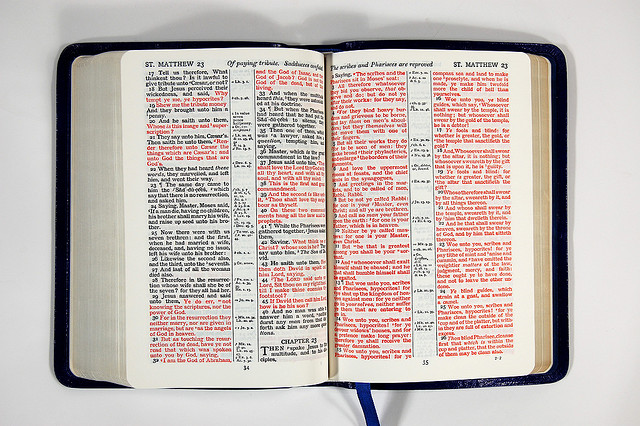The Feast of St. Matthew
AM Psalm 119:41-64; Isaiah 8:11-20; Romans 10:1-15
PM Psalms 19, 112; Job 28:12-28; Matthew 13:44-52
Like many kids, somewhere along the line I was given a Bible for some sort of prize in Sunday School. I still remember that the most interesting part to me was it was a “red letter” Bible, which had all of the quotations attributed to Jesus in red ink. What I remember most is that Matthew had more red ink than the other Gospels–quite a bit more–which in my kid-logic way made me decide Matthew was the best of the four Gospels. As I got older, though, Matthew lost its favored position–once I could read better, I discovered that one can get a little lost in all those quotes.
(Nerdy obscure detail alert: Did you know the red letter Bible was invented by Louis Klopsch in 1899? Part of the rationale was that the King James Bible didn’t use quotation marks, and this would aid the reader in defining the quotes.)
I’ve always wondered why Matthew used quotations so extensively, and I’ve never really stumbled across much of an explanation of that. It’s certainly a common literary device, though, to let the character dialogue allow the reader to form his or her own opinions, and Matthew flows well in that respect. Many scholars also believe that this book’s intended audience was Jewish converts to Christianity and there might well have been a tendency to “let Jesus do the talking.”
It’s a mistake, though, I believe, to make the Book of Matthew all about the words. When we live for Christ, we become the embodiment of those words. In short, we become red-letter people–quotes attributed to Jesus, in human skin. We become, as our Gospel reading today illustrates, a slice of the treasure in the field, or a smidgen of the Pearl of Great Price. To be a red-letter person means we, like the Gospel of Matthew, let Jesus do the talking.
When is a time Jesus did the talking for you in such a way, that you caught a glimpse of the red-letter life?
Maria Evans, a surgical pathologist from Kirksville, MO, is a grateful member of Trinity Episcopal Church and a postulant to the priesthood in the Episcopal Diocese of Missouri. She occasionally finds time to write about the obscurities of life, medicine, faith, and the Episcopal Church on her blog, Kirkepiscatoid.
Image: From Flickr

